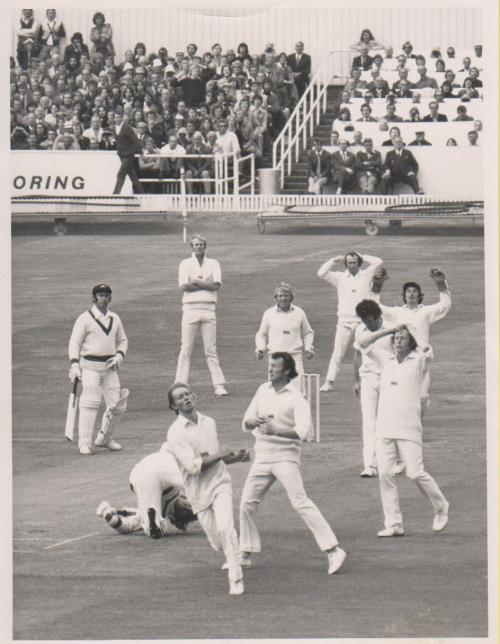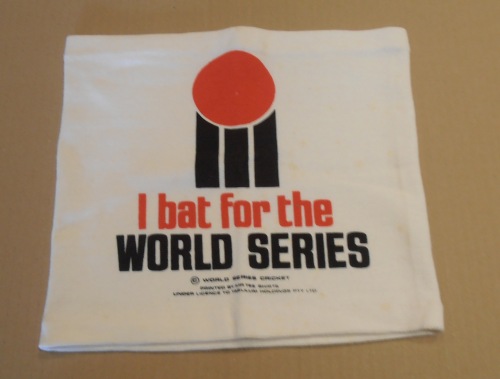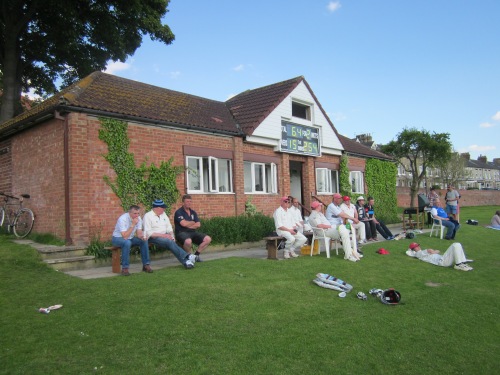In a recent digital story Arjuna Ranatunga bemoans the dominance of ‘carnival cricket’ and the threat it poses to the longer form of the game. http://www.takingthefield.com/stories/protecting-test-cricket .
I was surprised to learn that limited overs cricket didn’t really develop until the 1960s, and even then it would have looked very much like ‘normal’ cricket. One-day cricket as we now know it, with music, coloured clothing, day-night matches etc could probably be accredited to Kerry Packer.

1975 Prudential World Cup semi-final. Games were played in traditional whites with the red ball and all matches were daytime matches.
In the very early days of cricket matches were often low scoring, meaning that they could often finish within a day with all 4 innings being bowled. But as batting techniques improved 3 day games became the county norm. One-day games were played during World War 2, usually fundraising events, but these matches depended on generous declarations rather than restricted overs to ensure a result within the day. In 1956 a MCC research committee suggested a limited-overs county knockout competition be introduced to attract more spectators, but the suggestion wasn’t taken up. It wasn’t until 1963 that a limited overs contest, the Gillette Cup, was finally launched and the world had to wait until 1971 for the first official international one-dayer – and even this only came about as a last resort to offer the crowds a meaningful contest after the first 3 days of a test match in Melbourne were rained off.

World Series cap worn by the Australians team, now part of the MCC museum collection. Coloured caps and kit were a real novelty when they first appeared.
It was Kerry Packer’s World Series in 1977 that seriously increased the profile of the shorter game. Surrounded by a range of controversies this series introduced many of the now familiar features of limited-overs cricket including day night matches, coloured clothing and white balls. I’m not sure whether Kerry Packer intended to invent all these new features. He wanted to attract a big TV audience and knew the best way to do this was to have the cricket on in the evening and night primetime, so floodlights were needed, but the players had a problem seeing the red ball well under artificial light so it was changed to white, but then they couldn’t pick up the ball from the cricket whites so the next step was coloured clothing. Not that I think all the changes had a practical origin, you only have to look at our collection of mementoes to realise that this was intended to be a livelier more colourful style of cricket!

WSC ‘boob tube’, also in the MCC collection. Not sure if you’d get away with wearing that in the Lord’s pavilion!
Intentional or not Packer had a real and lasting impact on the world of cricket, and this was even recognised by some at the time. Wring in 1978 Henry Blofeld stated – “Already Packer has had a considerable effect on cricket, and if he were to disappear tomorrow his influence would remain.”
So is Test Cricket safe? I certainly hope so and if the sell out crowd today at Lord’s is anything to go by then I think it will be safe for a while yet.
(Further reading – One-Day Magic edited by Ken Piesse. One-Day Cricket by David Lemmon. The Packer Affair by Henry Blofeld. All available in the MCC library.
Cricket boob-tubes and many other unexpected exhibits can be seen in the MCC museum at Lord’s)



